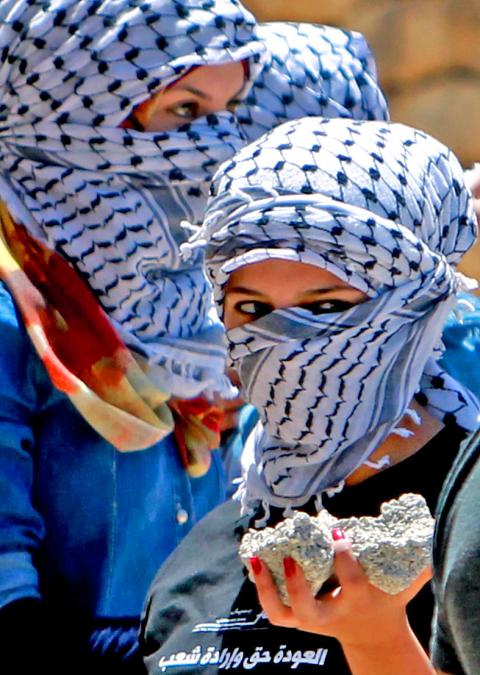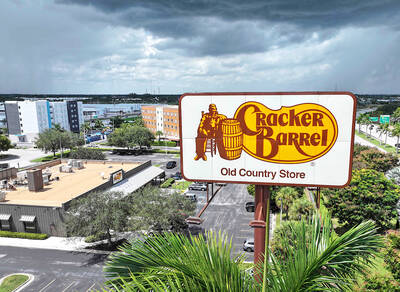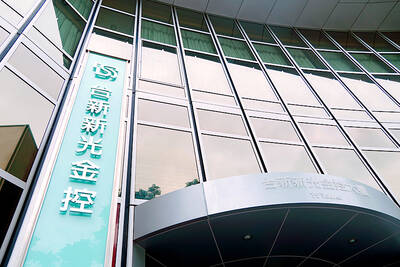In the face of strong competition from China, the traditional, locally produced Palestinian headscarf has put up a show of resistance, successfully pulling itself back from the brink of extinction.
Thanks to the business sense of two brothers from the southern West Bank city of Hebron, the traditional black-and-white keffiyeh headscarf has discovered a new lease of life.
In 1961, their father, Yasser Hirbawi, who sold keffiyehs he brought from Syria and Jordan, decided to set up his own production line.

Photo: AFP
When the factory began, two employees managed two looms to produce the famous black-and-white patterned headscarf.
Today, his sons are at the head of a business which employs 15 people and exports keffiyehs worldwide, all of them bearing the logo: Made in Palestine.
Each year, they sell about 30,000 scarves, of which 2 or 3 percent are sold locally while the rest go overseas with the main markets in Italy, France and Germany, most of which are ordered online, according to Juda Hirbawi.
Paradoxically, it was the British who turned the keffiyeh into a widespread symbol of resistance during the time of Palestine under their mandate (1920-1948), says Abdelaziz al-Karaki, 61, who has spent more than four decades working in the Hirbawi factory.
“They said that anyone who wore the Bedouin scarf was an opponent and suddenly everyone started wearing them,” he said.
However, the keffiyeh’s appearance on the international scene can be put down to the influence of one man: former Palestine Liberation Organization leader and Palestinian president Yasser Arafat, who was hardly ever pictured without his trademark headscarf.
Thanks to him, the headscarf was pictured at the UN, on the White House lawn and in Oslo, when Arafat was jointly awarded the Nobel Peace Prize, along with former Israeli prime ministers Shimon Peres and Yitzhak Rabin for their Middle East peace efforts.
And it is a portrait of the late leader in his keffiyeh that greets visitors at the entrance to Hirbawi’s factory.
“Arafat used to offer a keffiyeh to all his distinguished visitors and today, keffiyehs from our factory are still offered by his successor [Palestinian President] Mahmoud Abbas,” said Juda, speaking over the roar of the looms, which are now automated.
His factory has made a big comeback.
At the start of the past decade, in the face of strong competition from China and India, who were selling keffiyehs at one-third of the price, he decided to shut down the factory.
“They literally flooded the market. With their prices, we just couldn’t compete,” he said.
It was a tough decision for a family whose production line had lived through decades of conflict and the first Palestinian uprising (1987-1993) and had survived the rigors of daily life in the Israeli-occupied territories.
Although the factory was closed for five years, it gave them time to come up with a new strategy.
“We could never beat them on price, so we decided to focus all our efforts on quality,” said Juda, who has to import all his raw materials for lack of local alternatives, from thread to the automatic looms.
As well as quality, they have had to adapt the keffiyeh to international demands.
“Foreigners want different colors, so we have had to revisit the traditional style,” he said.
Hard at work, the looms are fitted with not only the traditional black-and-white thread, but also red for the Jordanian version. From turquoise and petrol blue, to pearl grey and lemon yellow, these days, the keffiyeh comes in all hues and shades.
And it is not only used as a scarf. It can be worn as a tunic, reworked as a shoulder bag or transformed into pockets.
The eye-catching fabric with its checkered effect has spread far and wide.
Whether it is dancers on TV, US rap artists filming a video or Palestinians competing in the Arab Idol talent show, they are all wearing the scarf.
This revival of sorts has drawn some measure of skepticism among those who have never stopped wearing it.
“It is the symbol of Palestine,” said Abu Fahmi al-Kisswani, a Palestinian from annexed east Jerusalem.
“For some people, it’s perhaps just a fashion accessory,” said Maria, a woman from Uruguay who had just purchased a scarf in Jerusalem’s Old City.
For her, the keffiyeh means more than that: It is a way of “showing solidarity with the Palestinians.”
Down a neighboring alleyway, Yussef Sinjlawi has just sold three keffiyehs.
Tourists, he said, are keen to take them home as a memento.
“Some tourists don’t want to pay too much, so we offer them keffiyehs for 25 to 30 shekels [US$7.50]” which are Chinese or Indian-made, whereas a “good quality keffiyeh costs 70 to 80 shekels,” said Bassem Barakat, who has worked as a shopkeeper in the Old City for three decades. “It’s up to them to choose.”
He himself has already made his choice.
“Like all Palestinians, I have my keffiyeh — and it comes from Hebron,” he said.

Taiwan Semiconductor Manufacturing Co (TSMC, 台積電) secured a record 70.2 percent share of the global foundry business in the second quarter, up from 67.6 percent the previous quarter, and continued widening its lead over second-placed Samsung Electronics Co, TrendForce Corp (集邦科技) said on Monday. TSMC posted US$30.24 billion in sales in the April-to-June period, up 18.5 percent from the previous quarter, driven by major smartphone customers entering their ramp-up cycle and robust demand for artificial intelligence chips, laptops and PCs, which boosted wafer shipments and average selling prices, TrendForce said in a report. Samsung’s sales also grew in the second quarter, up

On Tuesday, US President Donald Trump weighed in on a pressing national issue: The rebranding of a restaurant chain. Last week, Cracker Barrel, a Tennessee company whose nationwide locations lean heavily on a cozy, old-timey aesthetic — “rocking chairs on the porch, a warm fire in the hearth, peg games on the table” — announced it was updating its logo. Uncle Herschel, the man who once appeared next to the letters with a barrel, was gone. It sparked ire on the right, with Donald Trump Jr leading a charge against the rebranding: “WTF is wrong with Cracker Barrel?!” Later, Trump Sr weighed

HEADWINDS: Upfront investment is unavoidable in the merger, but cost savings would materialize over time, TS Financial Holding Co president Welch Lin said TS Financial Holding Co (台新新光金控) said it would take about two years before the benefits of its merger with Shin Kong Financial Holding Co (新光金控) become evident, as the group prioritizes the consolidation of its major subsidiaries. “The group’s priority is to complete the consolidation of different subsidiaries,” Welch Lin (林維俊), president of the nation’s fourth-largest financial conglomerate by assets, told reporters during its first earnings briefing since the merger took effect on July 24. The asset management units are scheduled to merge in November, followed by life insurance in January next year and securities operations in April, Lin said. Banking integration,

LOOPHOLES: The move is to end a break that was aiding foreign producers without any similar benefit for US manufacturers, the US Department of Commerce said US President Donald Trump’s administration would make it harder for Samsung Electronics Co and SK Hynix Inc to ship critical equipment to their chipmaking operations in China, dealing a potential blow to the companies’ production in the world’s largest semiconductor market. The US Department of Commerce in a notice published on Friday said that it was revoking waivers for Samsung and SK Hynix to use US technologies in their Chinese operations. The companies had been operating in China under regulations that allow them to import chipmaking equipment without applying for a new license each time. The move would revise what is known